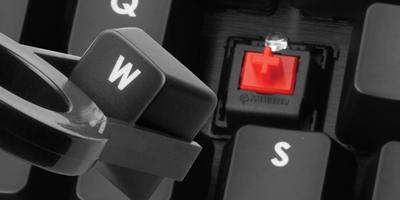 IBM Model M metal backplate. Source: Geek Hack.
IBM Model M metal backplate. Source: Geek Hack.
One of the reasons the IBM Model M – one the most widely-used original mechanical keyboards – is regarded so highly is its high, durable build quality. The durability stems from its steel backplate, used for mounting the mechanical switches; similarly, high-end mechanical keyboards of today often use metal backplates for switch mounting. While metal backplate mounting is widespread in mechanical keyboards, other materials -- such as plastic and PCB -- are also used to mount switches, with each having their own advantages.
Today, we’re looking at keyboard backplates and comparing metal vs. plastic and PCB options.
PCB Mounting
PCB mounting is the cheapest option for mounting switches, but doesn’t feel as solid as other solutions because it allows the keyboard to flex and bend. While PCB mounting is acceptable and works, it is generally used on cheap keyboards (especially non-mechanical), and we would suggest avoiding keyboards using PCB mounting unless on a tight budget.
Plastic Backplate Mounting
Plastic backplate mounting is more rarely used than PCB mounting or metal backplate mounting, but its advantages make it interesting and unique. The main downside to plastic backplate mounting is that it can feel – and usually is, in my experience – slightly less solid than metal, but the difference is usually insubstantial. The advantage to plastic backplate is that it can be cheaper, lighter, and more importantly -- depending on the type of plastic -- it can help disperse backlighting more evenly. This is in contrast to metal backplates and PCBs, which reflect the light without much disbursement. This is due to the way that LEDs are mounted on Cherry and Kailh switches – excluding RGB variants – with the LED on top, which casts a shadow from the LED and the switch. This produces uneven backlighting.
 A normal cherry switch with an LED.
A normal cherry switch with an LED.
The use of a white, opaque, plastic backplate can help diminish the reflection of the LED and uneven lighting. The Razer Blackwidow Chroma is a good example of this. Overall, a plastic backplate is satisfactory, and has its advantages, but is rarely used.
Metal Backplate Mounting
Metal backplate mounting is very common in mechanical keyboards, due to its durability and solid feel. Metal backplates are fairly simple in that they provide high durability, rigidity, and a solid feel, but can make keyboards much heavier by nature of using metal. Metal backplates can also resonate depending on the design of the keyboard. Many manufacturers choose metal backplates in order to create a more solid feel when typing and to help the keyboard last longer. Generally, a metal backplate will feel more solid than a plastic one, but this does depend a bit on thickness and the type of metal/plastic.
Steel is one of the most-used metals in backplates for mechanical keyboards.
A few examples of keyboards using metal backplates are: the Corsair K70, Cooler Master Rapid TKL, and Poseidon Z all use metal backplates. Even budget keyboards like the Nixeus Moda oftentimes use metal backplates. I personally prefer, and suggest, metal backplate mounting due to its durability and rigidity.
Final Thoughts
PCB, metals, and plastics all are acceptable for switch mounting in keyboards, and each have their own advantages and disadvantages. When choosing a mechanical keyboard, be sure to consider what type of mounting might work best for your uses -- but don’t let it outweigh the importance of switch choice, keycaps, and other factors.
That being said, the IBM Model M is a great example of how well a properly constructed keyboard with a metal backplate can stand up to abuse that a PCB likely couldn’t.
- Michael "The Bear" Kerns.